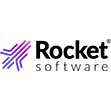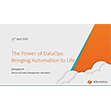

(unicro/Shutterstock)
Tracking down sources of data quality problems is a notoriously difficult task. But with its update to its Data Intelligence offering, Rocket Software is giving users the ability to navigate their organization’s data landscape in a graphical manner, which it likens to a “choose your own adventure” for data lineage tracking.
Rocket Software has been selling the Data Intelligence suite since it obtained it with the acquisition of ASG Technologies in 2021. The software previously was aimed at enabling highly skilled data engineers to tackle data quality problems, predominantly in highly regulated industries like financial services, often with a lot of mainframes.
This month, the company rolled out a major refresh of Data Intelligence designed to put actionable data lineage information in the hands of a much larger pool of business users. A big component of that work was creating a new graphical interface, called Data Intelligence Explorer, that depicts the organization’s data in a map-like manner.
The product functions a bit like Google Maps but for data lineage instead of the physical world, says Chris Wey, who is president of Rocket’s Data Modernization practice.
“Google Maps is a really intuitive way to zoom in and zoom out in a very user-friendly way,” he tells Datanami. “So if you zoom all the way into an intersection, for example on Google Maps, you can see the crosswalk, you can see the traffic lights, you can see what’s happening at that intersection. But as you zoom out, you get this abstraction and the details go away, but you can see the total picture.”
As the user zooms into a data entity in Data Intelligence Explorer, they’re able to see the actual database records that are the source, as well as any data transformation routines that may be modifying the data before it ends up in a BI report or dashboard, Wey says.

The new Data Intelligence Explorer provides a “choose your own adventure” for tracking data quality problems, Rocket Software says
“If there’s an ETL attached to that, what is the transformation? Are you adding three leading zeros to this number? Are you appending this ZIP Code with country code or whatever the case may be?” Wey says. “When you zoom out, you can now see your entire enterprise, all of the systems, from start to finish, and you can see different abstractions. You can see the sensitive data. You can zoom into other parts of your organization. And so that’s the simplicity that we’re bringing, this idea of lineage diagrams, which we think is going to be really powerful for business users.”
The GUI provides a “choose your own adventure” approach that will allow regular business users to begin tracking down data quality issues, Rocket says in a YouTube video on the new product. It’s a big improvement on the existing Data Intelligence product, which offered a GUI that wasn’t very easy to use, Wey says.
“You needed to be an expert,” he says. “You really need to understand the details of what was happening. And the way to zoom in and zoom out wasn’t just with the click of a mouse or a plus and minus button. There were specific functions to do everything you needed to do in the old product. So it was just not as user-friendly.”
That difficulty limited the old product to more technical users, such as data engineers or BI experts. With the new product, any user with a question about the source of a particular piece of information in their Tableau report or Looker dashboard will have a way to begin understanding where it came from. They’ll be able to start understanding what happened to that data while it was traveling from the transaction system, through the ETL tool, into data warehouse, and ultimately their BI tool or dashboard.
“You don’t have to go to IT and open up a ticket every time you want to understand where your data comes from,” Wey says. “You can click on the application, find your report, drill down into the source of the data and say, ‘Well my number came from this field in NetSuite and the other guy’s using the other field in NetSuite. Is it currency adjusted? Maybe the currency adjustment had an impact on your using the plan rates versus the actual rates on the currencies and that led to the difference in the outcome, for example.’”
Business users won’t have the ability to fix every data problem detected with Data Intelligence Explorer, Wey says. In many cases, a technical expert from the IT department may ultimately be needed to fix the problem. But the capability to follow the lineage of particular pieces of data as it navigates from a data sources through a transformation and into final report will help to spur conversations and ultimately lead to quicker, better resolution, he says.
Data Intelligence doesn’t actually track each individual piece of data as it flows within an organization. Such a system is probably impossible to build. Instead, the product relies on metadata to build a model of the data flow within an organization. It supports a catalog of 200 connectors and scanners to gather this metadata from various transaction systems–from cloud-based ERP systems to IBM mainframes and IBM i servers, as well as data warehouses, ETL tools, and BI tools.
It also uses tags to track specific pieces of high-value data, like personally identifiable information (PII). Tags are useful for enabling traceability, Wey says, but they often get lost amid the myriad complexity and massive volume of enterprise data systems. Simplifying the interaction with the metadata-derived lineage diagrams is the path that Rocket chose to bolster usability with this release.
“These lineage diagrams are incredibly complex. If you think about hundreds if not thousands of applications and all of the connections to all of the data fields and diving in and out of these complex diagrams–it’s incredibly complex,” he says. “This lineage is incredibly useful in providing that clarity for business reports, for compliance reports. But the big desire that we’ve had for customers over the years is to expand this simplicity and the ease of use for our business users.”
Rocket also rolled out a more attractive licensing mechanism aimed at getting Data Intelligence Explorer, which is a Web-based product into the hands of more users. The old interface is still there, too. For more information, see www.rocketsoftware.com.
Related Items:
Data Quality Is Getting Worse, Monte Carlo Says
September 19, 2025
- Cisco and Qumulo Partner to Bridge the Data Gap from Edge to Core to Cloud
- Adastra Achieves Elite Partner with Databricks to Accelerate AI-Driven Innovation
- Digital.ai Strengthens Key and Data Protection with White-box Cryptography Agent
- Datalinx AI Builds Leadership Team to Transform Messy Data Into Actionable Intelligence
- Huawei Cloud Showcases Global Infrastructure, Data, and AI Engines at HUAWEI CONNECT 2025
- ScaleOut Software Delivers Next-Gen Caching with Version 6
- Argonne: Turning Materials Data into AI-Powered Lab Assistants
- EY Announces Alliance with Boomi to Offer Broad Integrated Solutions and AI-Powered Transformation
- Rice University Accelerates AI Innovation to Transform Teaching, Learning and Research
- Tigera Launches Solution to Protect AI Workloads Running on Kubernetes
September 18, 2025
- EDB Research Shows 87% of Enterprises Lag in Sovereign AI Adoption
- Zencoder Brings AI Coding to a Billion Users with Universal AI Development Platform
- PingCAP Brings Global Data Leaders Together for TiDB SCaiLE 2025 in California
- Qlik Connect 2026 Set for April 13–15 in Florida
- Domo Selected by Showpass to Deliver Scalable, Real-Time Embedded Analytics Worldwide
- Databricks Launches AI Accelerator Program to Scale the Next Generation of AI Startups
- Kennesaw State Researchers Tackling AI-Generated Fraud to Protect Data Integrity
- Salesforce Deepens Commitment to UK AI Innovation, Increases Investment to $6B
September 17, 2025
- Inside Sibyl, Google’s Massively Parallel Machine Learning Platform
- What Are Reasoning Models and Why You Should Care
- Rethinking Risk: The Role of Selective Retrieval in Data Lake Strategies
- In Order to Scale AI with Confidence, Enterprise CTOs Must Unlock the Value of Unstructured Data
- The AI Beatings Will Continue Until Data Improves
- Beyond Words: Battle for Semantic Layer Supremacy Heats Up
- Software-Defined Storage: Your Hidden Superpower for AI, Data Modernization Success
- How to Make Data Work for What’s Next
- What Is MosaicML, and Why Is Databricks Buying It For $1.3B?
- Top-Down or Bottom-Up Data Model Design: Which is Best?
- More Features…
- Mathematica Helps Crack Zodiac Killer’s Code
- GigaOm Rates the Object Stores
- Solidigm Celebrates World’s Largest SSD with ‘122 Day’
- Promethium Wants to Make Self Service Data Work at AI Scale
- AI Hype Cycle: Gartner Charts the Rise of Agents, ModelOps, Synthetic Data, and AI Engineering
- MIT Report Flags 95% GenAI Failure Rate, But Critics Say It Oversimplifies
- Data Prep Still Dominates Data Scientists’ Time, Survey Finds
- The Top Five Data Labeling Firms According to Everest Group
- Career Notes for August 2025
- Sphinx Emerges with Copilot for Data Science
- More News In Brief…
- Seagate Unveils IronWolf Pro 24TB Hard Drive for SMBs and Enterprises
- Gartner Predicts 40% of Generative AI Solutions Will Be Multimodal By 2027
- DataSnap Expands with AI-Enabled Embedded Analytics to Accelerate Growth for Modern Businesses
- Acceldata Announces General Availability of Agentic Data Management
- Qlik Announces Canada Cloud Region to Empower Data Sovereignty and AI Innovation
- Transcend Expands ‘Do Not Train’ and Deep Deletion to Power Responsible AI at Scale for B2B AI Companies
- Pecan AI Brings Explainable AI Forecasting Directly to Business Teams
- Databricks Surpasses $4B Revenue Run-Rate, Exceeding $1B AI Revenue Run-Rate
- SETI Institute Awards Davie Postdoctoral Fellowship for AI/ML-Driven Exoplanet Discovery
- Deloitte Survey Finds AI Use and Tech Investments Top Priorities for Private Companies in 2024
- More This Just In…






































